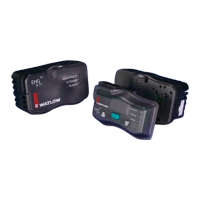Watlow Controls 3 EHG SL 10 User’s Manual
Up-Arrow Key
Increases the
displayed value.
Down-Arrow Key
Decreases the
displayed value.
Mode Key
Toggles the display between
the set point and process
temperature.
Alarm (flashing red)
Indicates that the process
temperature is higher than the
Set Point High Limit Alarm value.
Alert (solid red)
Indicates that the process
temperature is higher than the
High Alert Set Point.
Output (green)
Indicates that the process
temperature is below the set
point and the output is on.
In range (solid yellow)
Indicates that the process
temperature is between the
High Alert Set Point and Low
Alert Set Point values.
Flashing
Alert/Alarm (red) and
In Range (yellow)
If they are flashing together, that
indicates an Ambient Alarm
(controller temperature higher
than 85°C).
If they are flashing alternately, that
indicates a Health Check Error.
Proportional Control
Some processes need to maintain a
temperature or process value closer
to the set point than on-off control
can provide. Proportional control
provides closer control by adjusting
the output when the temperature
or process value is within a propor-
tional band. When the value is in
the band, the controller adjusts the
output based on how close the pro-
cess value is to the set point.
The closer the process value is to
the set point, the lower the output
power. This is similar to backing
off on the gas pedal of a car as you
approach a stop sign. It keeps the
temperature or process value from
swinging as widely as it would with
simple on-off control. However, when
the system settles down, the tem-
perature or process value tends to
“droop” short of the set point.
With proportional control the
output power level equals (set point
minus process value) divided by the
proportional band value.
Adjust the proportional band
with Proportional [`Pb].
Time
Temperature
Set Point
Proportional Band
Droop
Overshoot
Proportional plus Integral (PI)
Control
The droop caused by proportional
control can be corrected by adding
integral control. When the system
settles down, the integral value is
tuned to bring the temperature or
process value closer to the set point.
Integral determines the speed of the
correction, but this may increase
the overshoot at startup or when
the set point is changed. Too much
integral action will make the system
unstable. Integral is cleared when
the process value is outside of the
proportional band.
Integral [Int] is measured in
minutes per repeat. A low integral
value causes a fast integrating ac-
tion.
Proportional plus Integral
plus Derivative (PID) Control
Use derivative control to minimize
the overshoot in a PI-controlled sys-
tem. Derivative [dEu] adjusts the
output based on the rate of change
in the temperature or process value.
Too much derivative will make the
system sluggish.
Time
Temperature
Set Point
Reduced Overshoot
Proportional Band
Proportional Band x 2
Heating Slows
Alert/Alarm
In range
Output
Alert/Alarm
In range
Output
Alert/Alarm
In range
Output
Alert/Alarm
In range
Output
Alert/Alarm
In range
Output
Alert/Alarm
In range
Output
Alert/Alarm
In range
Output
flashing
flashing
alternate
flashing
Control
relay
LTA
HTA
relay
Safety
Alarm
relay
off off off
off off on
off on on
on on on
off off off Ambient Alarm
[Abt] 85°C
on off on
off off off Health Check Error
Normal Operating Range
Limit High Set Point [SLA]
High Temperature Alert [HtA]
Low Temperature Alert [LtA]
Temperature
Alarm Hysteresis
Alarm Hysteresis
On-Off Hysteresis [HyS]
Set Point
Keys and Indicator Lights

